Updated September 12, 2024
Are you ready to grab an attractive travel deal at a moment’s notice? Are you occasionally asked to pack your bags for an unexpected trip with little time to prepare? For these and other scenarios, a partially packed travel bag and other travel-ready packing tips may be just what you need to grab last-minute travel deals, accept invitations from travelling companions, or take work assignments involving travel.
Table of Contents
- Advantages of being ready to travel with little notice
- 20 Travel-ready packing tips
- 1. Identify a consistent place to stow travel gear
- 2. Be vigilant about the critical items
- 3. Work with a packing list
- 4. Know your limits
- 5. Be prepared with emergency medical insurance
- 6. Organize copies of important documents
- 7. Keep your emergency contact card up to date
- 8. Ensure your travel account and financial cards are always ready to go
- 9. Maintain an emergency cash stash
- 10. Keep foreign currency on hand
- 11. Keep cloud-based travel files up to date
- 12. Keep a password manager up to date
- 13. Ensure your devices are travel-ready
- 14. Maintain a stocked kit of toiletries and cosmetics
- 15. Have a ready-to-go health kit
- 16. Consider purchasing duplicates for home and travel
- 17. Have a pre-packed tech bag
- 18. Maintain a travel wardrobe
- 19. Unpack with the next trip in mind
- 20. Keep a travel bag partially packed
- Conclusion
Advantages of being ready to travel with little notice
Being partially prepared to travel any time
- takes the angst out of decision-making. It’s one less reason to decline, one more reason to accept.
- improves your ability to take advantage of spontaneous travel opportunities.
- removes some of the stress associated with getting ready to leave.
- promotes an organized approach to unpacking from a previous trip to be ready for the next.
- allows you to pack quickly if faced with time constraints.
- encourages and fosters a packing-light mindset. Packing in a hurry isn’t an excuse for overpacking.
20 Travel-ready packing tips
You may be a consummate planner who starts packing several weeks before a trip. In that case, the following tips will undoubtedly enhance your approaches to planning and preparation. If you’re a last-minute packer, integrating some of these strategies will allow you to pack faster and smarter. If you agree, please let me know in the comments.
1. Identify a consistent place to stow travel gear
When packing for previous trips, have you wasted time searching for items destined for your travel bag? If so, it might help to have designated places to store luggage, stash packing aids, hang travel clothing, store shoes set aside for travel, file a passport and related documentation, maintain a selection of travel-sized containers, and stow items packed for most trips.
For ‘dedicated travel stuff,’ travel drawers or shelves work for many people. Or use a tote box or two, each one with a lid. Being ready to travel on short notice means not wondering where something is or having to search for it. In this regard, I’m impressed by Mat Tee’s use of shelves stacked with labelled containers and other travel aids.
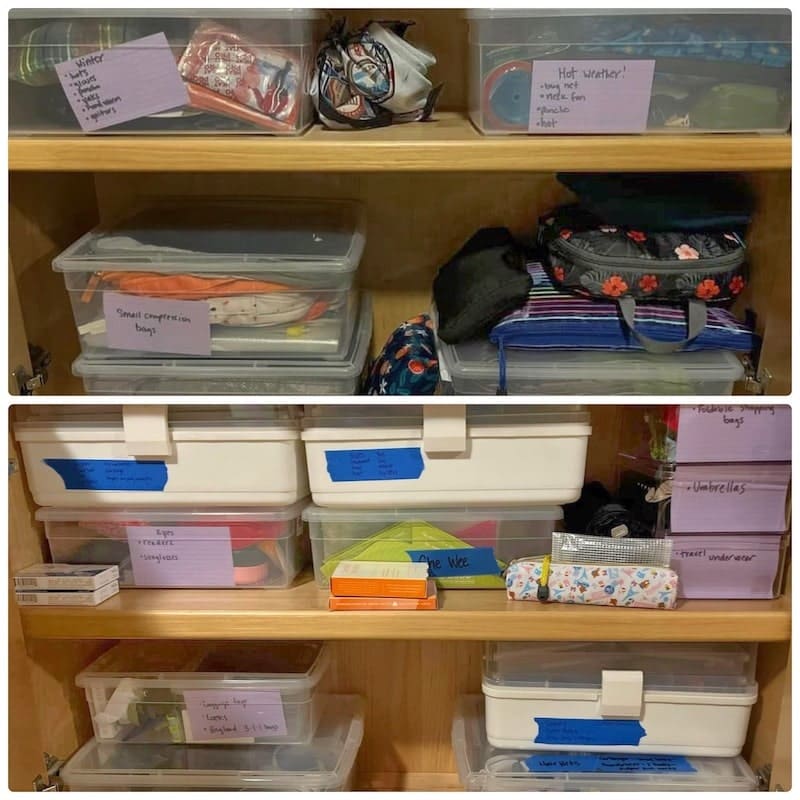 Photo credit: Mat Tee, used with permission
Photo credit: Mat Tee, used with permission
Also, make being travel-ready part of your everyday activities. Be on the lookout for solid alternatives to liquid toiletries and suggestions on travel clothing. Collect travel-sized containers to add to your collection. Do the same with pouches, zip-top bags, or other packing organizers. Having a selection means finding the right one for decanting purposes or storing related or miscellaneous items in a purse or bag.
Launder travel underwear from the last trip, pack it in its designated packing organizer, and add it to your travel drawer or partially packed travel bag.
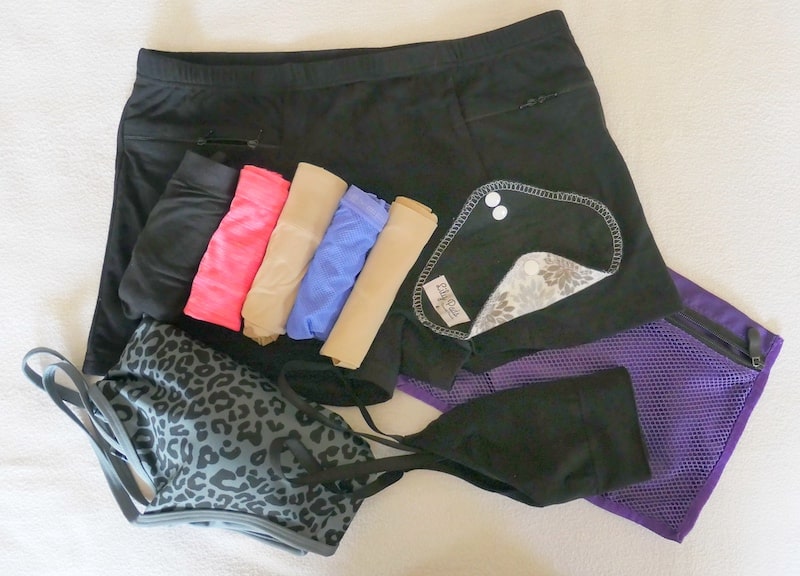
Reach for your travel umbrella or packable, lightweight rain jacket if rain is in the forecast. Put your hands on a hands-free travel organizer containing your passport, trusted traveller card, emergency contact card, and laminated emergency medical insurance policy card.
2. Be vigilant about the critical items
An expired or damaged passport is a liability. Or one that isn’t valid for at least six months beyond an intended stay or has enough empty pages to be stamped. So is a soon-to-be expired prescription for medication that’s vital to your well-being. These are scenarios that may be difficult to overcome without adequate notice.
3. Work with a packing list
I find a master packing list works best, unlike separate lists by season, destination, or type of trip. As much as 80 per cent of what you’ll pack applies to all trips, so create an electronic version. My obsessively comprehensive list has every possibility for past and future trips, including brand names, sizes, and weight in some cases. It’s amended regularly to eliminate discards and add new products.
Print a copy and check off items as they’re packed. Working with a hard copy offers more opportunities to quickly add handwritten notes or flag items to be packed within the last few hours of departure. Having a checklist for reference makes last-minute packing more efficient and less stressful.
4. Know your limits
If you’re a member of an airline’s frequent flyer loyalty program, you’ll likely travel on that airline or one of its partners. Remain up to date on baggage allowance policies regarding dimensions and weight. If it’s helpful, keep a record in a Notes app on your phone, along with the exact dimensions of your luggage. Purchase a portable luggage scale. Ensure your luggage strictly adheres to baggage allowances and pack accordingly. It’s too late when you reach the gate and encounter a hefty fee for checking a bag because your bag was too large for the luggage sizer.
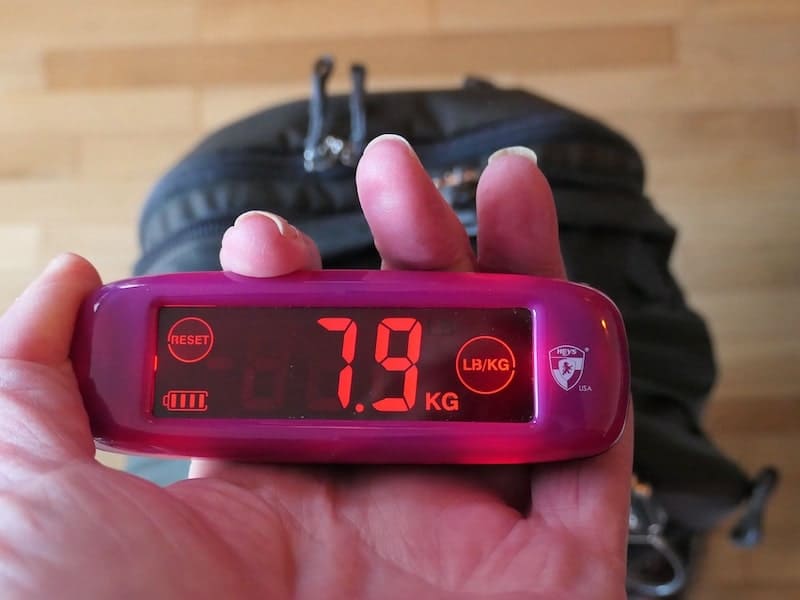
5. Be prepared with emergency medical insurance
Travelling without emergency medical insurance coverage is never a risk worth taking. Does your existing policy make you travel-ready? Is it valid for the length of your trip and covers pre-existing conditions related to recent health issues?
If your policy has lapsed, how quickly will you be able to obtain coverage online or over the phone? Do you travel enough to make an annual multi-trip plan a worthwhile investment? You may be surprised to discover that an annual plan may be slightly more expensive than a single-trip one.
6. Organize copies of important documents
Keep a scanned copy of the information page of your passport in your Dropbox (or other cloud-based service) or email account. A handy complement is a laminated copy carried with you at all times, with a spare packed in your luggage. It will be invaluable to confirm your identity, obtain an emergency passport, or seek medical attention.
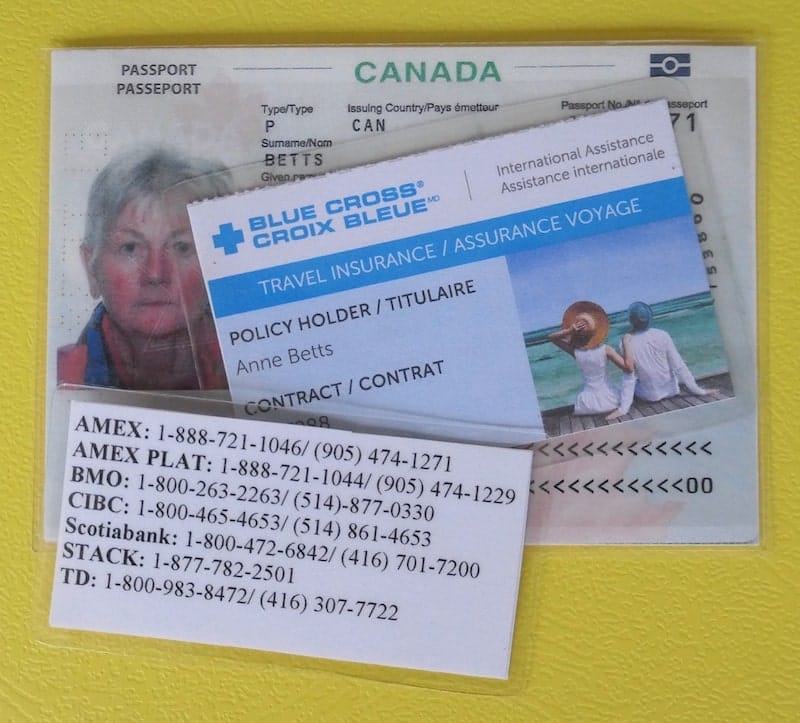
7. Keep your emergency contact card up to date
What number do you call to report a lost or stolen credit card when the credit card is no longer in your possession? Most emergency medical insurance policies require contact with the policy administrator before seeking medical attention. Do you have that number at your fingertips? What if you need to contact your country’s consular services for assistance? These telephone numbers and other information associated with emergencies can be recorded in a digital wallet but what if you’ve lost your phone or someone else needs to call on your behalf? This is when a laminated emergency contact card the size of a credit card can be handy. Make several copies to store each one in a wallet, phone case, and travel bag.
8. Ensure your travel account and financial cards are always ready to go
If relying on withdrawing cash from an ATM, ensure your travel account or pre-loaded financial card has the necessary funds. Not all pre-loaded cards are supported in all countries. Be aware of where your card is accepted.
Also, it’s wise to travel with more than one credit card from different card issuers and different financial institutions. Acceptance rates of American Express, MasterCard, and Visa vary, and one card could be blocked because of an issue with a PIN or suspected fraudulent activity. Or it could be an issue with the merchant’s terminal. I’ve had one card rejected, another accepted, and the rejected card accepted at another merchant’s terminal.
Download banking apps and familiarize yourself with them before travelling. Record essential details such as withdrawal limits and telephone numbers in a password manager. Having preauthorized payments set up on credit cards means one crucial task is handled automatically. Setting up voice recognition in advance will make contacting your financial institution much easier. In the case of two-step authentication, make sure you have the means to receive a text or call from your financial institution.
9. Maintain an emergency cash stash
As a backup, always carry an emergency cash stash. It will be handy if your purse is lost, stolen, or pickpocketed. Or you might discover that none of your cards works at one or more ATMs.
There are small diversion safes on the market to hide emergency stash. For example, a small Mennen Speed Stick container with fake deodorant, plastic lipstick containers, or a phony USB power bank is built for this purpose. Or make your own. Sew or tape a pocket in a packing organizer, or save a used container such as travel-sized deodorant, lip balm, or a band-aid dispenser for a DIY diversion safe.
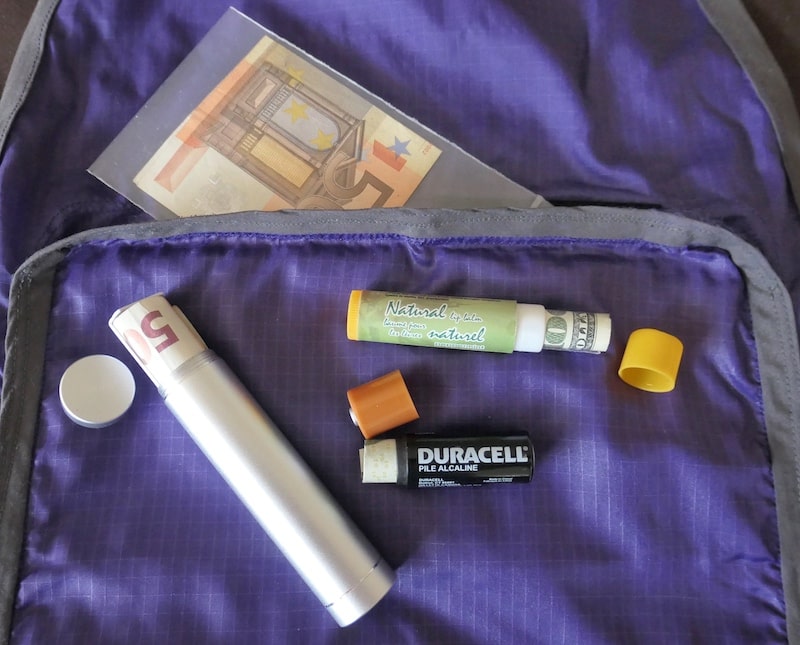
10. Keep foreign currency on hand
There may be delays involved in ordering foreign currency. Having a cache of local currency is handy when you first land in a foreign destination. It enables you to navigate public transportation, pay for small purchases, or tip service providers.
If you’ve travelled to that area before and are likely to pass through or travel there again, consider purchasing leftover foreign currency from travelling companions at the current exchange rate before returning home. It saves on fees for everyone. Organize leftover foreign currency in see-through sleeves cut from page protectors. Keep a handy list of foreign currencies and their value in a Notes app on your phone.
11. Keep cloud-based travel files up to date
You undoubtedly have files that accompany you on all trips. These might include a user manual for your camera, emergency medical insurance policy, vaccination certificate, and various documents or spreadsheets. Filing them in a cloud-based storage system makes them accessible while on the move. Also, ensure you have the right apps or programs to update them while travelling.
12. Keep a password manager up to date
Each time a password changes or information relating to one of your accounts is modified, take a few moments to update your password manager. It will be invaluable when trying to access accounts from afar.
13. Ensure your devices are travel-ready
Is your phone network unlocked? Have you set up biometric controls such as facial recognition or fingerprint access? Do you have a Virtual Private Network (VPN) subscription? Have you downloaded your chosen airline apps and set them to receive notifications regarding check-in and flight delays? Do you and your key contacts have a VoIP app such as WhatsApp to video and audio chat using Wi-Fi? Have you paired your luggage tag tracker with your phone? Do you have a selection of playlists, movies, podcasts, and other forms of entertainment downloaded? What are the costs of your carrier’s roaming packages? If you have lounge passes as one of your credit card benefits, have you downloaded the app and set up your account? Is your phone eSIM compatible? As Uber is a popular rideshare option in many countries, have you downloaded the app and established an account to book an Uber on the fly?
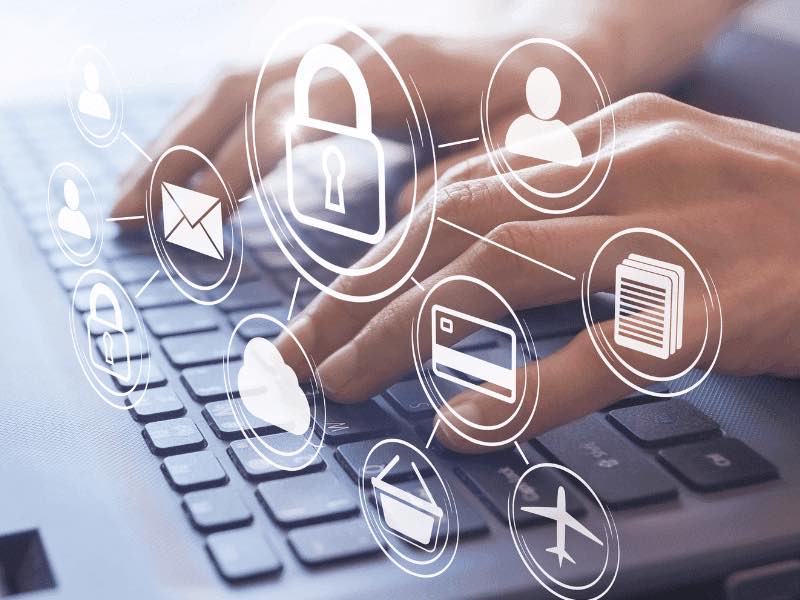
Managing these and many other issues means you can rely on your devices for navigation, banking, research, booking travel, entertainment, social media and email management, and communicating with folks back home.
14. Maintain a stocked kit of toiletries and cosmetics
Your travel toiletries most likely consist of many of the same products you use at home. The difference may be that they’re in travel-sized containers and packed in a small hanging toiletry kit.
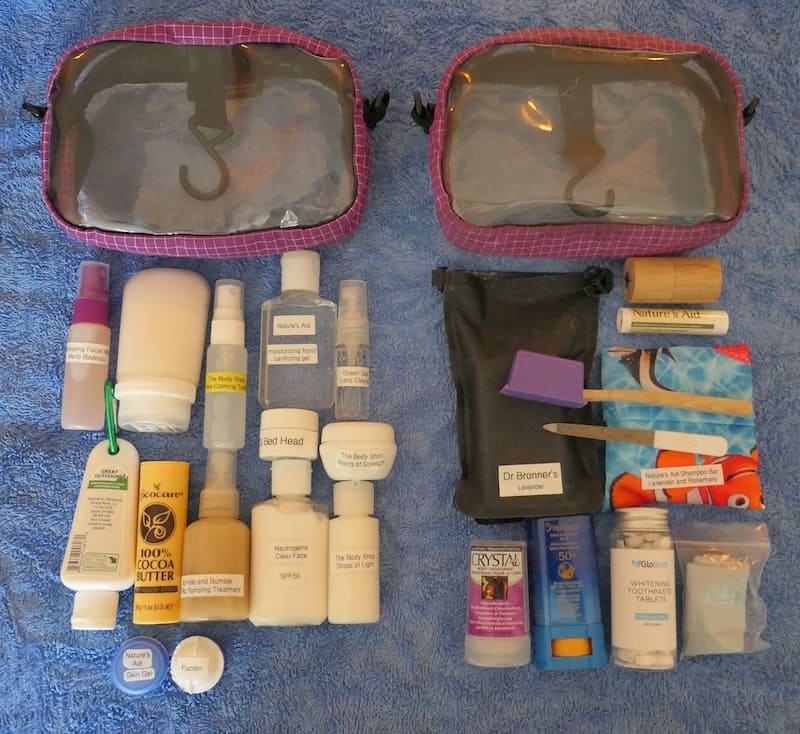
- If your trips are of a predictable duration, decant enough for that many days — no more, no less.
- Label everything. It removes the guesswork from similar-looking products.
- Clean empty containers at the end of one trip and add enough product to be travel-ready for the next. If the next trip is longer, top-up containers as necessary.
- Toiletries and cosmetics have expiration or Period After Opening dates. Keep these in mind when assembling and replenishing your toiletry kit.
15. Have a ready-to-go health kit
A small first-aid kit with the basics will serve you well when travellers’ diarrhea, a headache, cuts and scrapes, bug bites, and other ailments strike. Maintain a related collection of health aids for sanitizing, hydration, gut health, and immune support. Include pressure-reducing earplugs and other in-flight essentials for a healthy flight.
Review your collection occasionally to discard expired items and order replacements.
16. Consider purchasing duplicates for home and travel
Consider buying duplicates for items consistently used at home and while travelling. It avoids the possibility of overlooking them when packing. This might include chargers, a travel adapter, a small flashlight, a refillable water bottle, a pen, a sleep mask, and a pocket shopping bag.
17. Have a pre-packed tech bag
Relying heavily on devices creates pressure to ensure they remain secure, charged, and able to safely venture into cyberspace. Your tech bag might include an international adapter, charging cords with the correct connectors, a headphone jack, a data blocker, and an adaptor for connecting wireless headphones to an in-flight entertainment system.
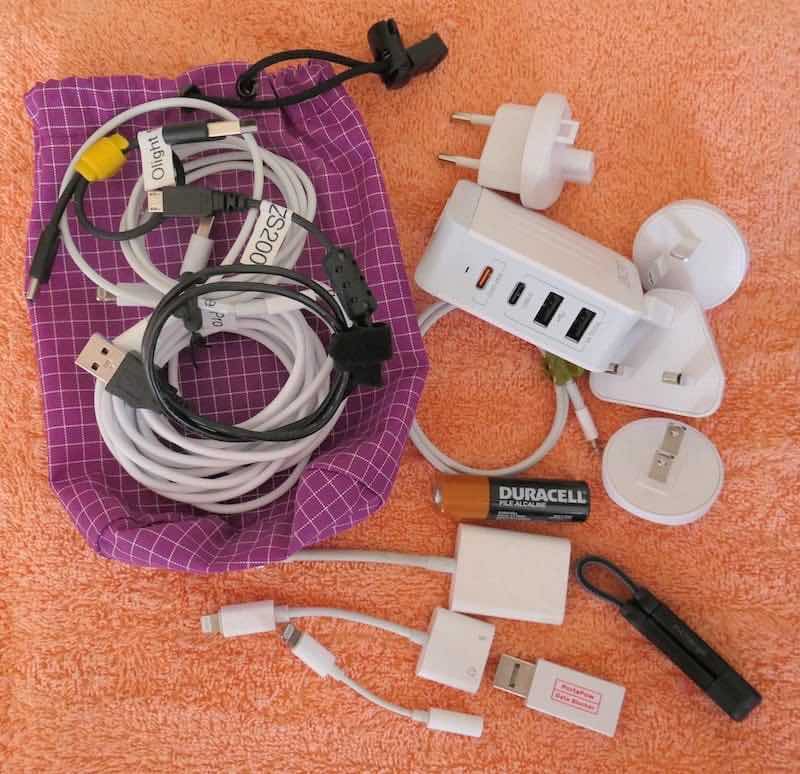
A grab-and-go bag that can be quickly packed alleviates collecting charging cords and accessories from around the house on the eve of departure. Leave home with the knowledge you’ll have what you need to power up and connect with confidence throughout your trip.
- inCharge X keyring charging cable review of a tech favoutie
- Do you need a USB data blocker when you travel?
- Pack light with a USB to AC international travel charger
18. Maintain a travel wardrobe
If packing clothes is a significant challenge, consider setting aside lightweight, quick-drying, tried-and-true pieces of a capsule wardrobe and reserving them for travel. Choose versatile pieces that are wrinkle-resistant and can be mixed and matched to create multiple outfits with fewer items.
Exploring destinations can be a pleasurable or painful experience depending on your choice of shoes. Once you’ve found comfortable, versatile footwear that blends with your capsule wardrobe, consider setting it aside for travel. For most destinations, I pack my AllBirds Wool Runners, Teva Tirra sandals, and Havaianas Slim to use as slippers and shower shoes.
It’s reassuring to know that I can easily walk at least 20 kilometres / 12 miles in my tried-and-tested AllBirds Wool Runners or Teva Tirra sandals. In neutral colours, both can transition to smart casual wear when going out for supper. By setting them aside for travel, they retain their like-new look for several trips.
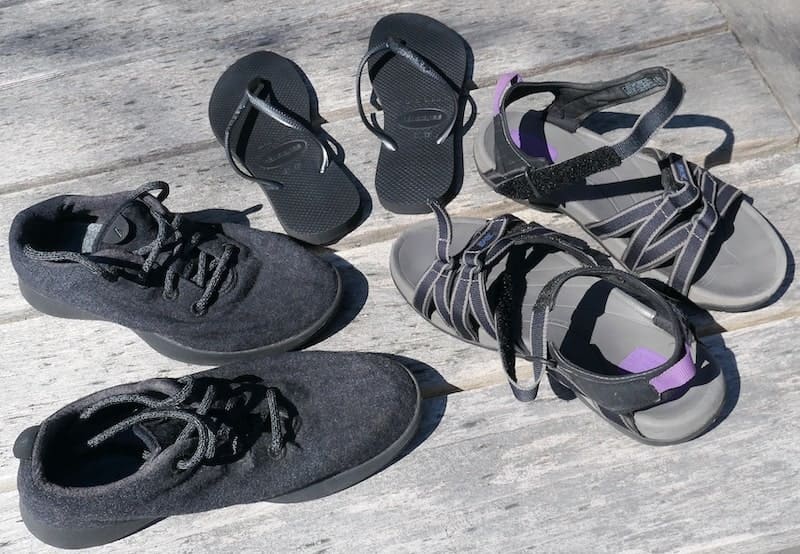
A ready-to-go sewing kit you assemble will contain thread that matches your travel wardrobe. Spare buttons will also match; add them to your sewing kit or attach them to the inside of the respective piece of clothing.
19. Unpack with the next trip in mind
Unpack as soon as possible from each trip. While doing so, incorporate a post-trip debrief with yourself as it relates to packing. Make a note of what wasn’t worn or used, what worked or didn’t work, and amend your packing list accordingly.
Launder travel clothes, clean and dry shoes, replenish or clean out travel-sized toiletries, and wash and dry your reusable water bottle.
20. Keep a travel bag partially packed
Only partially unpack from each trip. Keep items routinely packed for every trip within your semi-packed travel bag. If you’re a fan of packing cubes and other packing organizers, leave your favourites in the bag. These might include a laundry bag, shoe bag, dry bag to keep moisture in or out, a compression sac for bulky clothing, or tried-and-trusted clothing folders and cubes.
Conclusion
Packing with little notice is a scramble that many travellers face, often leading to forgotten essentials or overpacked suitcases. Preparing to take advantage of last-minute travel opportunities involves having systems to facilitate quick and efficient packing.
If you found this post helpful, please share it by selecting one or more social media buttons. What are your packing tips for being ready to travel with little notice? Please add your suggestions and thoughts in the comments. Thank you.
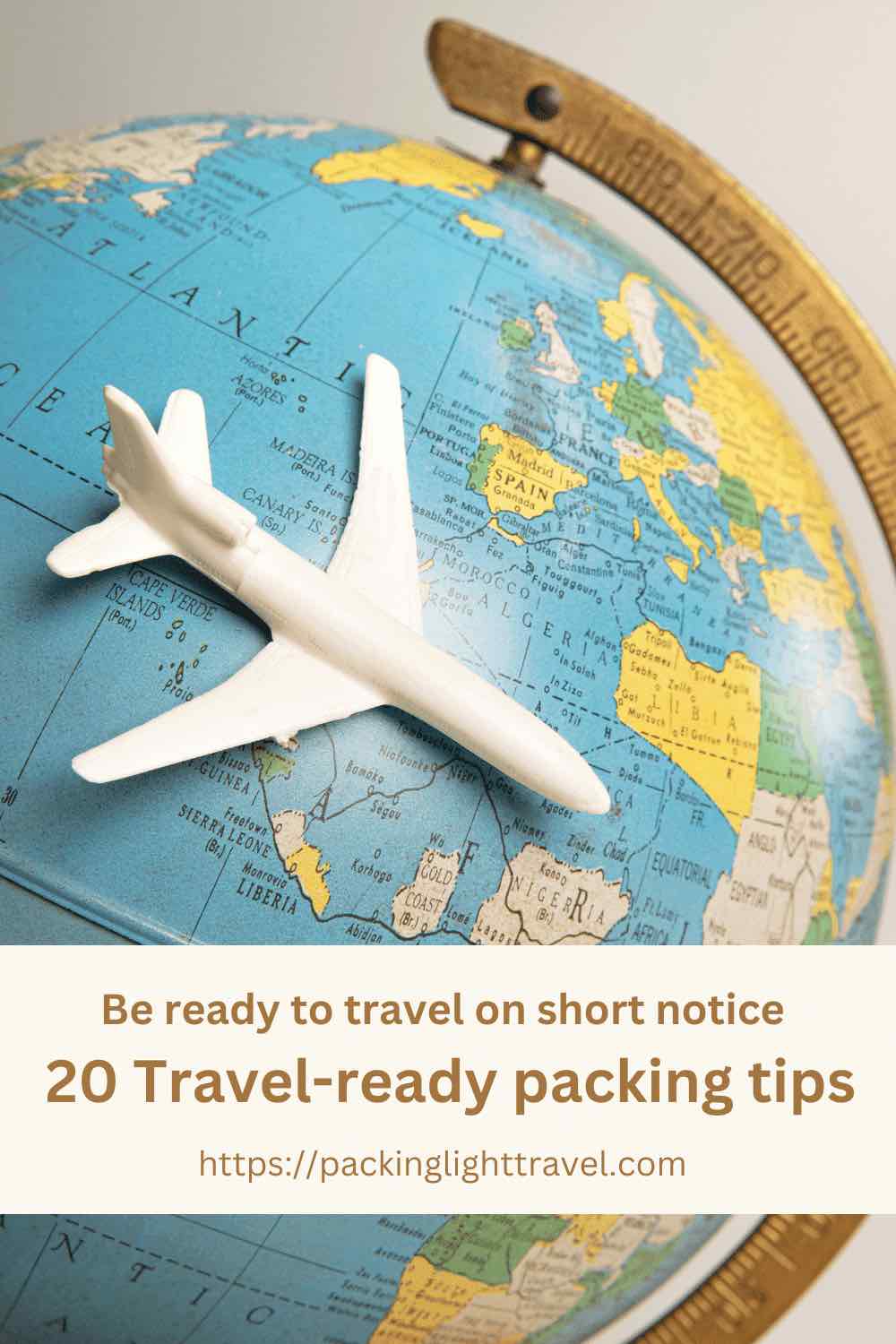
The Amazon links are affiliate links. If you click on one and purchase something, you don’t pay more but Packing Light Travel earns a small commission which helps with the costs of maintaining the site. Thank you for your support.






I find these tips are good even for the planned vacation. I can’t tell you my frustration when I have to go to the pharmacy or department store to purchase expensive medicines (such as aspirin) or clothes items because I forgot to pack. I recommend keeping a list in your suitcase entitled “Things I Need On Every Trip.”
Excellent tips. Keeping travel stuff organized at home always helps me when it’s time to pack – whether it’s spur of the moment or not.
Great advice! I feel like your tip about keeping everything well organized/knowing where it is is huge! You can pack a lot faster if everything is already in a place you know of and can put things together quickly!
So useful! I also find having a master packing list is the best option, and I do it all the time, but apart from my slippers & jandals already in the backpack, I unpack and pack again every time … I’m definitely gonna do the travel underwear thing!
Great tips. My husband travels a lot for work and has a stash of foreign cash from around the world (separated by location). It definitely helps to have a little change on hand when you arrive in country.
This is a wonderfully written post, and it makes total sense. Your tips will help any traveler. Experienced or not so experienced traveler.
Angela Lowe recently posted…Travel to Rome: 3 Days in the Eternal City, Plus Basic Tips!
What a great article! So many useful tips. A travel many years and I consider myself being good in packing for my trips, still I did not think about about emergency contact card, for example. Thanks for sharing!
So many great tips. It’s always good to be prepared for any sudden travel plans. My brother-in-law recently had a heart attack so it was good I didn’t forget anything as I rushed out the door!
Thanks for sharing your personal experience with this. It adds a lot of credibility to your suggestions. What challenges did you face when implementing these ideas?